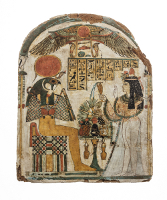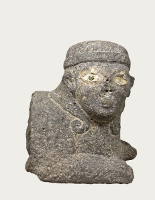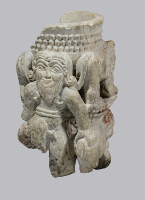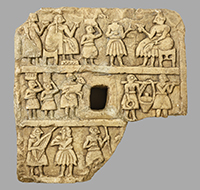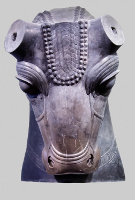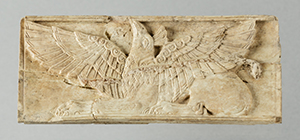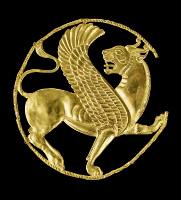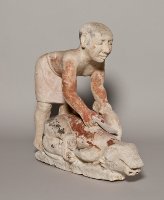Highlights from the Collection: Animals
Funerary Stela
Found in the Ramesseum at Thebes, this painted funerary stela was erected to commemorate the lady Djed-Khonsu-es-ankh. The deceased woman, in a diaphanous white gown, wears a cone of perfumed beeswax and a water lily on her head. She pours a libation over a table of food offerings and raises her hand to greet the seated god Re-Harakhty, a form of the ancient Egyptian sun god. The hieroglyphic signs offer a prayer asking the gods to supply food and drink for the survival of her spirit in the netherworld.
The inscription, a standard offering formula, reads:
An offering which the King gives to Re-Harakhty, the Great God, Lord of Heaven, that he may give invocation-offerings consisting of offerings and food to the Osiris, Lady of the House, the noblewoman, Djed-Khonsu-es-ankh, deceased, daughter of the priest of Amun-Ra, King of the Gods, Master of the Secrets of the Garments of the Gods, Ser- Djehuty.
Relief from the Tomb of Mentuemhat
The ancient Egyptians decorated the walls of their tombs with elaborate scenes showing the type of life they wished to live after death. This relief fragment comes from the tomb of Mentuemhat, a governor of Thebes. One of the most powerful men of his time, Mentuemhat was able to employ the best artists to carve and paint scenes of abundance that would satisfy his every need in the afterlife.
In the relief above, oarsmen paddle small boats made of papyrus bundles through waters teeming with fish. The first boat contains two oarsmen and a third figure, perhaps identified as an overseer by his staff (?) and gesture, sitting between wicker baskets piled high with fruit.
Beaker with Geometric Designs and Birds
Archaeologists working in Iran at the site of Tepe Giyan during 1931 and 1932 excavated 119 burials dating to five successive periods. Among the vessels characteristic of the Giyan II Period were ones whose decoration combined geometric patterns with representations of small suns and birds. This beaker, acquired by the archaeologist Ernst Herzfeld prior to the 1930's excavations, thus can be dated by its decoration to Giyan II.
Kernos Ring
This ring was probably used as a libation vessel during religious ceremonies in ancient Palestine. It consists of a hollow clay ring with hollow clay attachments in the forms of a gazelle head, two jars, two pomegranates, two doves, and a cup. The doves, whose heads have been restored, drink from the cup. An eighth attachment is missing, having been broken off in antiquity.
The pomegranate, the gazelle and the doves suggest that this ring was associated with a fertility cult. Wine or water would have been poured into the cup and circulated through the other objects attached to the ring, thus symbolizing the fertility of the earth and its produce.
Kernos rings are fairly common in Palestine, although few are as elaborate or as well preserved as this one.
Predynastic Jar
Most striking of the painted designs on this pot are the boats, which carry banks of oars, cabins or shrines, and standards. Other decorations include a large bird, probably an ostrich, and images evocative of the hills and water of Upper Egypt, where this vessel was made. Strings probably were passed through the four pierced beak-shaped lugs near the rim and used to tie a lid securely in place. Handmade pots with painted decorations like these were characteristic of the Gerzean period.
Statue of the God Horus
This statue represents the falcon god Horus, one of the most important ancient Egyptian gods. The beak and headdress have been restored to suggest the originals, which were almost certainly made of gold. A narrow passage from the base of the statue to the head may have been used for the insertion of cords to manipulate the original beak and headdress. In that way the statue could have functioned as an oracle-a medium through which the god made known his knowledge and purpose.
Human-Headed Winged Bull
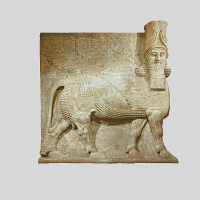 This colossal sculpture was one of a pair that guarded the entrance to the throne room of King Sargon II. A protective spirit known as a "lamassu", it is shown as a composite being with the head of a human, the body and ears of a bull, and the wings of a bird. When viewed from the side, the creature appears to be walking; when viewed from the front, to be standing still. Thus it is actually represented with five, rather than four, legs.
This colossal sculpture was one of a pair that guarded the entrance to the throne room of King Sargon II. A protective spirit known as a "lamassu", it is shown as a composite being with the head of a human, the body and ears of a bull, and the wings of a bird. When viewed from the side, the creature appears to be walking; when viewed from the front, to be standing still. Thus it is actually represented with five, rather than four, legs.
Bronze Band
 The fortress of Sargon II at Khorsabad included a complex of temples, one of which was devoted to the sun god Shamash. This bronze band encircled one of a pair of cedar poles-possibly supports for divine emblems-that once flanked the doorway to this temple. The band was affixed to the pole by nails driven through the centers of the rosettes that decorate the three narrow bands framing the two main registers.
The fortress of Sargon II at Khorsabad included a complex of temples, one of which was devoted to the sun god Shamash. This bronze band encircled one of a pair of cedar poles-possibly supports for divine emblems-that once flanked the doorway to this temple. The band was affixed to the pole by nails driven through the centers of the rosettes that decorate the three narrow bands framing the two main registers.
In the upper register, Sargon is shown grasping two massive bulls by the horns. This ancient motif, known as "the master of animals," was well established in Mesopotamian royal iconography and perhaps symbolized the dominance, vitality, and potency of the reigning monarch. To the left of the king and bulls is a large bird depicted in flight, to the right, facing the king and bulls, is an attendant wearing a kilt. In the lower register, only a fig tree and the tip of a plough are preserved.
Pair of Bull Statuettes
 These two bulls probably once adorned the top of a royal or divine standard (or the tops of a pair of such standards). The treatment of their surfaces is unusual-one half of each bull was covered with what may be a copper-arsenic plating (probably originally silver in color), the other half with copper. While the copper surface has become corroded, the portion covered with the arsenical metal remains essentially intact.
These two bulls probably once adorned the top of a royal or divine standard (or the tops of a pair of such standards). The treatment of their surfaces is unusual-one half of each bull was covered with what may be a copper-arsenic plating (probably originally silver in color), the other half with copper. While the copper surface has become corroded, the portion covered with the arsenical metal remains essentially intact.
Female Sphinx
Sphinxes-imaginary creatures composed of a lion's body and a human head-are a motif that originated in Egypt and became common in the art of Western Asia beginning in the latter part of the second millennium B.C. This recumbent sphinx of local Syrian manufacture has an unusually vivacious character due to the position of the head, which is turned sideways with the chin slightly raised, not at the stiff right angle often found in ancient Near Eastern sculpture. Its hair is secured with a headband knotted at the back of the head and falls in two large curls onto its breast. The dowel hole in the base of the body indicates that it was part of some large object-possibly an arm of a stone throne.
Striding Lion
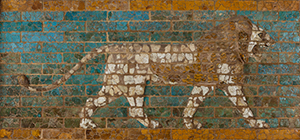 This colorful striding lion, its mouth opened in a threatening roar, once decorated a side of the 'Processional Way' in ancient Babylon (the Biblical city of Babel). The 'Processional Way' led out of the city through a massive gate named for the Mesopotamian goddess of love and war, Ishtar, whose symbol was the lion. Each year, during the celebration of the great New Year Festival, the images of the city's deities were carried out through the Ishtar Gate and along the 'Processional Way' past some 120 lions such as this one to a special festival house north of the city.
This colorful striding lion, its mouth opened in a threatening roar, once decorated a side of the 'Processional Way' in ancient Babylon (the Biblical city of Babel). The 'Processional Way' led out of the city through a massive gate named for the Mesopotamian goddess of love and war, Ishtar, whose symbol was the lion. Each year, during the celebration of the great New Year Festival, the images of the city's deities were carried out through the Ishtar Gate and along the 'Processional Way' past some 120 lions such as this one to a special festival house north of the city.
Cup Supported by Hero and Animals
This elaborate vessel was discovered in the Shara Temple where it was probably used to place offerings before the god. The decoration of its openwork support shows a hero, naked except for a double-strand belt, grasping the rumps of two lions in his hands. The curling tails of two additional lions are tucked under his arms, and all four felines menace a bearded bull at the opposite end of the stand. Series of figures such as these, engaged in static combats, are common in ancient Mesopotamian art. Their exact meaning is unknown.
Banquet Plaque
The top register of this plaque shows a seated man and woman celebrating an unidentified event or ritual by participating in a banquet. Two servants attend them while others bring a jar (probably filled with beer), an animal to be slaughtered, and other edibles carried in bundles on their heads. Musicians and dancers in the bottom register add to the festivities.
Plaques such as this were part of a door-locking system for important buildings. The plaque was embedded in the doorjamb and a peg, inserted into the central perforation, was used to hold a hook or cord that secured the door and was covered with clay impressed by one or more seals.
Gazelle-Head Stamp Seal/Amulet
In central and southern Mesopotamia, both stamp and cylinder seals appeared together near the end of the third millennium B.C. Many stamp seals were carved in the form of an animal or an animal head, and the sealing surface was decorated with simple designs - often representing animals - comprised of drill-holes and incised lines. It is possible that many of the stamps were not actually used as seals but were worn primarily as amulets.
Cylinder Seal
This cylinder seal was dedicated to a little-known goddess, Ninishkun, who is shown interceding on the owner's behalf with the great goddess Ishtar. Ishtar places her right foot upon a roaring lion, which she restrains with a leash. The scimitar in her left hand and the weapons sprouting from her winged shoulders indicate her war-like nature.
Duck Weights
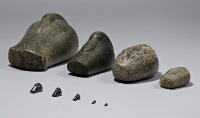 The Mesopotamians used sets of standard weights in conducting business and set stiff penalities for those who used false weights. The weights themselves were usually made of a very hard stone like hematite. A simple barrel shape was the most common form, but weights such as these in the form of a duck, with its neck and head resting along its back, were also prevalent.
The Mesopotamians used sets of standard weights in conducting business and set stiff penalities for those who used false weights. The weights themselves were usually made of a very hard stone like hematite. A simple barrel shape was the most common form, but weights such as these in the form of a duck, with its neck and head resting along its back, were also prevalent.
Colossal Bull Head
Carved in the court style typical of the Achaemenid Empire, this highly polished stone head originally belonged to one of two guardian bulls flanking the portico of the hundred-columned Throne Hall at Persepolis. The heads of the bulls projected in the round and the bodies were carved in relief on the sidewalls of the porch; the ears and horns had been added separately. The use of pairs of guardian figures such as these to protect important buildings was a common architectural feature in the ancient Near East.
Frieze of Striding Lions
 An Achaemenid artisan carved this piece of stone to represent part of a cloth canopy that was decorated with woven or appliquéd figures of rosettes and striding lions. Remnants of crenellations on the top of the block indicate that it belonged to the uppermost row of stones. The fringe along the lower edge, representing knotted cords ending in tassels, was partly chipped away in ancient times, perhaps before the stone was reused in the balustrade of a small stairway east of Darius' residential palace.
An Achaemenid artisan carved this piece of stone to represent part of a cloth canopy that was decorated with woven or appliquéd figures of rosettes and striding lions. Remnants of crenellations on the top of the block indicate that it belonged to the uppermost row of stones. The fringe along the lower edge, representing knotted cords ending in tassels, was partly chipped away in ancient times, perhaps before the stone was reused in the balustrade of a small stairway east of Darius' residential palace.
A pair of diamonds joined as a figure-eight can be seen in three places on the face of this stone. They are the marks of the sculptor or team of sculptors who carved this and numerous other Persepolis reliefs on which the same marks appear.
Krater with Ibexes
The geographical term "Susiana," referring to the area ruled in the historical period by the city of Susa, is also applied to the prehistoric cultures of lowland southwestern Iran. Representational designs such as the stylized wild goats with long sweeping horns painted beneath the rim of this krater are characteristic for an advanced stage of the Susiana sequence.
Griffin Plaque
This plaque is one of a group of ivories discovered at Megiddo in a semi-subterranean chamber that archaeologists called the "treasury," within a large building that may have been a palace. It bears the figure of a reclining griffin-a composite creature with a lion's body and a bird's head and wings. This motif is borrowed from the art of the Mycenaeans, but it is uncertain whether the object itself was made by a Mycenaean craftsman settled in Asia, by a local ivory carver imitating Mycenaean prototypes, or was imported directly from Greece.
Persian Roundel
This snarling winged lion worked in gold repoussé attests to the exceptional skill of Achaemenid goldsmiths. The back of the horned feline's body and the slender twisted cord that surrounds it bear sixteen tiny loops for attachment to a garment or textile. Greek writers often speak of the tremendous wealth of the Persians, and Herodotus writes that King Xerxes' troops "were adorned with the greatest magnificence...they glittered all over with gold, vast quantitites of which they wore about their persons" (vii.83).
Butcher Slaughtering a Calf
This statuette of a butcher is one of a group of sculptures placed in the tomb of an ancient Egyptian official so that he might take with him into the afterlife things that had been important to him during his lifetime. The group, which seems to represent the household and staff of a typical prosperous estate owner in Old Kingdom Egypt, included representations of the owner Ny-kau-Inpu and his family, two butchers, men and women processing grain and making bread, four musicians, a metalworker with a blowpipe, a potter, and even two children playing leapfrog.

